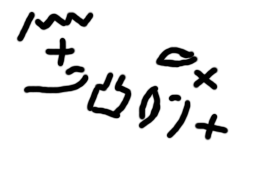Spoken words are the symbols of mental experience, and written words are the symbols of spoken words.
– Aristotle
A Brief History
For thousands of years of human pre-history, communication was only verbal. As societies became more complex, we developed means of written communication. At first crude pictures were used to represent common objects, then concepts and phonetic sounds. These early forms of written communication are known as pictograms and, later, hieroglyphs.
The first alphabetic system -- a writing system which uses abstract symbols to represent sounds (phonemes) which are combined into words -- grew out of Egyptian heiroglyphic writing. Known as Proto-Sinaitic script, it appeared in the Sinai peninsula around the 15th century BCE.
 |
| A specimen of Proto-Sinaitic script, one of the earliest (if not the very first) phonemic scripts (Wikipedia) |
The English word alphabet comes to us from the Greek ἀλφάβητος (alphabētos), from alpha and beta, the first two letters of the Greek alphabet. Alpha and beta in turn came from the first two letters of the Phoenician alphabet, and originally meant ox and house respectively.
The Adobe Suite -- InDesign (for layout) and Illustrator and Photoshop (for pictures and special typography) -- contains tools for communication. The graphic artist communicates ideas with a combination of pictures (illustrations and photos) and words (type) which combine in a layout. Simply put,
Text + Pictures = Layout
Note that not all layouts are a combination of text and pictures, some are simply one or the other. No matter what the layout, a graphic artist must combine design abilities with technical knowledge.
Pictures as a form of communication
Since we use an alphabet does it mean pictures are no longer important in communication? No, indeed. Pictures are still a very effective means of communication. We "read" pictures much as we do words, but we understand on an intuitive level and do not require common language to transmit their meaning. Consider, for instance, these international wayfinding symbols developed by AIGA in 1974 :
An ideogram or ideograph (from Greek ἰδέα idea "idea" + γράφω grafo "to write") is a graphic symbol that represents an idea or concept. They can also be called pictograms or pictographs. They convey meaning through pictorial resemblance to a physical object. Earliest examples of pictographs include ancient or prehistoric drawings or paintings found on rock walls. Pictographs are also used in writing and graphic systems in which the characters are to considerable extent pictorial in appearance. [1][2]
 |
Native American pictographs from the
Great Gallery, Horseshoe Canyon, Canyonlands National Park (Wikipedia) |
 |
| A pictograph warning against swimming because of crocodiles at the Australia Zoo. (Wikipedia) |
Pictography is a form of writing which uses representational, pictorial drawings. It is a basis of cuneiform and, to some extent, hieroglyphic writing, which uses drawings also as phonetic letters and ideograms. [2]
 |
| Babylonian cuneiform |
 |
| Hieroglyphs typical of the Graeco-Roman period (Wikipedia) |
A logo is an ideogram — a graphic mark or emblem commonly used by commercial enterprises, organizations and even individuals to aid and promote instant public recognition. Logos are either purely graphic (symbols/icons) or are composed of the name of the organization (a logotype or wordmark). An example of an abstract mark is the blue octagon representing Chase Bank, while an example of a representational mark is the "everyman" icon of PBS. Examples of well-known logotypes (wordmarks) are the striped IBM design, Mobil written in blue with a red "o" and CocaCola written in flowing red script. [3]
Here are three famous logos: an abstract mark (Chase Bank by Chermayeff & Geismar), a logotype (IBM by Paul Rand), and a pictorial mark (Girl Scouts of the USA by Saul Bass, 1978). Wikipedia.com
 |
| The Chase Bank logo |
 |
| Read about the evolution of the IBMcorporation and logo |
 |
| The Girl Scouts logo was recently redesigned. Read about it here. |
A monogram is a motif made by combining two or more letters to form one symbol. Letters are often overlapped and are sometimes abstracted. Monograms are often made by combining the initials of an individual or a company, used as recognizable symbols or logos.[4]
 | |
| Albrecht Dürer's monogram on a wood engraving (1498). |
 |
| Mark Twain's monogram MT on the cover of his book The American Claimant. |
 |
| The Univerity of Texas monogram |
What's the difference between logos and monograms? A monogram is the combined initials of any name while logo is the graphical presentation of a company or individual. A monogram can be a logo but logo can't always be a monogram.
I made some monograms with my initials:
Watch:
[1] http://en.wikipedia.org/wiki/Ideogram
[2] http://en.wikipedia.org/wiki/Pictogram
[3] http://en.wikipedia.org/wiki/Logo
[4] http://en.wikipedia.org/wiki/Monogram
http://en.wikipedia.org/wiki/Alphabet
http://en.wikipedia.org/wiki/Heiroglyph
http://www.aiga.org/content.cfm/symbol-signs



No comments:
Post a Comment